Dracula
CS! Gold
 Join Date: Sep 2002
Join Date: Sep 2002
Posts: 26,102 
Likes: 5,731
Location:
Member is Online
|
Post by Dracula on Nov 21, 2015 20:46:40 GMT -5
60. The Night of the Hunter Year Year: 1955 Director: Charles Laughton Writer(s): Charles Laughton and James Agee Starring: Billy Chapin, Sally Jane Bruce, Robert Mitchum, Shelley Winters, and Lillian Gish Based on: The novel "The Night of the Hunter" by Davis Grubb Studio: United Artists Country of Origin: USA Language: English Running Time: 92 Minutes Aspect Ratio: 1.66:1 Night of the Hunter seems to sort of fit into a lot of trends without comfortably conforming to any. Is it a Noir? Sort of, it’s certainly got a shadowy visual style and a bleak world view but its rural setting makes it pretty distinct. Is it perhaps more of a Southern gothic? It’s certainly Southern and a bit gothic, but its focus on children and on the lower class kind of pushes it away from that. Is it a horror movie? It’s villain, played deliciously by Robert Mitchum certainly pushes it towards that genre in a number of ways, but it isn’t really trying to scare its audience really. The auteur theory doesn’t really help unravel the mystery too much given that it is the only film that actor Charles Laughton ever directed. It is of course rather strange that Laughton, a genteel Brit of a certain generation, managed to make a movie that’s so loaded with American iconography. Maybe the reason the film is so hard to classify is because it’s so bold and original in many ways. Laughton wasn’t content to do simply make something that was cookie cutter. He certainly drew from a lot of great Hollywood genre traditions, but what he ended up making was almost more of an art film, albeit one with a lot of really accessible thriller moments and images.
|
|
Jibbs
Administrator  Join Date: May 2000
Join Date: May 2000
Posts: 75,725 
Likes: 1,657
Location:
Last Online Feb 20, 2024 18:06:23 GMT -5
|
Post by Jibbs on Nov 21, 2015 23:05:41 GMT -5
Yes! Duck Soup! One of my all time favorites.
|
|
Dracula
CS! Gold
 Join Date: Sep 2002
Join Date: Sep 2002
Posts: 26,102 
Likes: 5,731
Location:
Member is Online
|
Post by Dracula on Nov 22, 2015 10:22:27 GMT -5
59. Blade Runner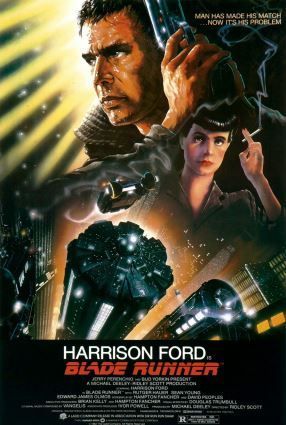 Year Year: 1982 Director: Ridley Scott Writer(s): Hampton Fancher and David Peoples Based on: The novel "Do Androids Dream of Electric Sheep" by Phillip K. Dick Starring: Harrison Ford, Rutger Hauer, Sean Young, and Edward James Olmos Distributor: Warner Brothers Country of Origin: USA Language: English Running Time: 117 Minutes Aspect Ratio: 2.35:1 His track record is pretty spotty now, but with his first two Hollywood movies Ridley Scott gave us one of the greatest one two punches in film history. The second of the two, Blade Runner, stands out as one of the most ambitious and creative science fiction films to come out of Hollywood. The film is perhaps most famous for its exquisitely detailed futuristic Los Angeles sets, depicting a city where it always seems to be nighttime, overcrowding is rampant, and Japan seems to have the dominant culture. The film cleverly uses the conventions of film noir to make the film a sort of futuristic detective story with Harrison Ford as the central gumshoe put in the middle of a morally dubious case. The film leans into this “future noir” gimmick just enough to give the film an interesting flavor without making it feel silly. Beneath the surface this is actually a pretty serious science fiction film based on a Phillip K. Dick novel which asks poignant questions about what it means to be human and whether machines deserve rights and it did it before these questions had become total science fiction clichés. The movie went out to theaters in a compromised form in 1982, but over the years it’s been recut a number of times and as time went by it’s been recognized as one of the most intriguing movies to ever come out of the studio system.
|
|
IanTheCool
CS! Gold
 Join Date: Jul 2003
Join Date: Jul 2003
Posts: 21,493 
Likes: 2,864
Location:
Last Online Nov 22, 2024 23:08:59 GMT -5
|
Post by IanTheCool on Nov 22, 2015 12:48:16 GMT -5
Where does the name come from?
|
|
SnoBorderZero
CS! Silver
 Join Date: Jan 2004
Join Date: Jan 2004
Posts: 17,622 
Likes: 3,182
Location:
Last Online Nov 22, 2024 21:31:20 GMT -5
|
Post by SnoBorderZero on Nov 22, 2015 17:46:42 GMT -5
Where does the name come from? In the bonus documentary that comes with the blu-ray ultimate edition the screenwriter, Hampton Fancher, explained that he grabbed the title from a book about people smuggling surgical tools, hence the name Blade Runner. So it really doesn't have anything to do with it other than the title just being incredibly badass. Why are the elite detectives called them in the film? They don't say. |
|
Dracula
CS! Gold
 Join Date: Sep 2002
Join Date: Sep 2002
Posts: 26,102 
Likes: 5,731
Location:
Member is Online
|
Post by Dracula on Nov 22, 2015 20:59:39 GMT -5
58. Ikiru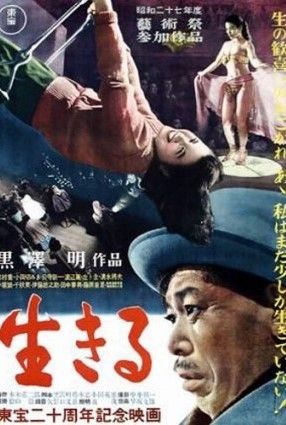 Year Year: 1952 Director: Akira Kurosawa Writer(s): Akira Kurosawa, Shinobu Hashimoto, and Hideo Oguni Starring: Takashi Shimura, Shinichi Himori, Haruo Tanaka, and Minoru Chiaki Distributor: Toho Country of Origin: Japan Language: Japanese Running Time: 143 Minutes Aspect Ratio: 1.37:1 Old age and dying are two aspects of the human experience which most directors need to tackle at some point. Most of them wait until late in their lives to get that degree of introspection but every once in a while you get a case like Ikiru, which Akira Kurosawa made when he was 42 and was more or less at the height of his career. The film is about an old man who has diligently worked all his life as a bureaucrat only to suddenly be diagnosed with a terminal cancer. The film is about what this dying man does knowing he doesn’t have long to live and knows he has to do something with his life. When he wasn’t making period films Kurosawa’s work always had a touch of Frank Capera in it, especially during the early post-war era. Ikiru is a good example of this in the way that it ultimately about a good person trying to do good in the face of an uncaring world. It feels like it’s about go down a fairly expected route, but then it suddenly pivots about 60% of the way through and flashes forward to after the protagonists death and sits in on his funeral as we hear people reminisce about how he manages to accomplish his big goal (the construction of a playground). It’s a really unconventional move but Kurosawa somehow manages to pull it off, leading to the film’s iconic image, the sight of the old man sitting on the park swing singing “Life is Brief” in the snow. It’s certainly not Kurosawa’s most funloving work, but it has an emotional power that transcends.
|
|
Dracula
CS! Gold
 Join Date: Sep 2002
Join Date: Sep 2002
Posts: 26,102 
Likes: 5,731
Location:
Member is Online
|
Post by Dracula on Nov 23, 2015 6:32:27 GMT -5
57. Amarcord Year Year: 1974 Director: Federico Fellini Writer(s): Federico Fellini and Tonino Guerra Starring: Bruno Zanin, Magali Noël, Pupella Maggio, and Armando Brancia Studio: F.C. Produzioni Country of Origin: Italy Language: Italian Running Time: 123 Minutes Aspect Ratio: 1.85:1 Amarcord is often thought to be Fellini’s last great film and by extension it almost kind of feels like an end of an era for the great world cinema boom that lasted through the 60s. By 1974 Godard had retreated into highly experimental work, Kurosawa was having trouble getting financing, Buñuel would only make one more film, Truffaut had moved away from the New Wave style that made him famous, Bergman still had a number of good films left in him but he was less than a decade from retirement too. This is of course only something we know in retrospect, Fellini certainly didn’t know he was making the film that would be viewed as the swan song of his “classic period” but what a wonderful finale it is. Set during the fascist era and autobiographical in many ways, the film is a bawdy and irreverent rumination on memory and nostalgia. It’s essentially an episodic narrative that’s kind of (but not entirely) told from the perspective of a young boy who sees some of the horrors of Mussolini’s Italy on his periphery but is largely sheltered from it and because the film is told from his perspective the time still feels colorful and full of life. Fellini has no love for fascists and he certainly isn’t trying to suggest that this time period was actually like that, but he is showing what it was like to this young man who is presumably looking back on it with rose colored eyes as an adult. The film’s flights of fancy are very entertaining in their own rights and the way Fellini manages to bring them all together is really amazing.
|
|
IanTheCool
CS! Gold
 Join Date: Jul 2003
Join Date: Jul 2003
Posts: 21,493 
Likes: 2,864
Location:
Last Online Nov 22, 2024 23:08:59 GMT -5
|
Post by IanTheCool on Nov 23, 2015 9:59:31 GMT -5
All I know about Amarcord is that red outfit the woman wears in the covers.
|
|
Neverending
CS! Platinum
 Join Date: Jul 2003
Join Date: Jul 2003
Posts: 65,773
Likes: 8,648
Location:
Last Online Nov 22, 2024 18:30:10 GMT -5
|
Post by Neverending on Nov 23, 2015 11:17:03 GMT -5
|
|
PG Cooper
CS! Silver
 Join Date: Feb 2009
And those who tasted the bite of his sword named him...The DOOM Slayer
Join Date: Feb 2009
And those who tasted the bite of his sword named him...The DOOM Slayer
Posts: 16,647 
Likes: 4,062
Location:
Last Online Nov 22, 2024 22:27:20 GMT -5
|
Post by PG Cooper on Nov 23, 2015 13:12:29 GMT -5
60. The Night of the Hunter I actually dressed up as Harry Powell this year for Halloween. Awesome film. Didn't expect to see it on your list. |
|
Doomsday
Administrator  Join Date: Jan 2001
Join Date: Jan 2001
Posts: 23,298 
Likes: 6,764
Location:
Last Online Nov 22, 2024 20:26:39 GMT -5
|
Post by Doomsday on Nov 23, 2015 13:21:15 GMT -5
I actually dressed up as Harry Powell this year for Halloween. |
|
Dracula
CS! Gold
 Join Date: Sep 2002
Join Date: Sep 2002
Posts: 26,102 
Likes: 5,731
Location:
Member is Online
|
Post by Dracula on Nov 23, 2015 19:08:27 GMT -5
56. Pulp Fiction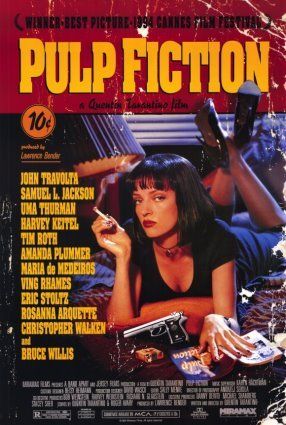 Year Year: 1994 Director: Quentin Tarentino Writer(s): Quentin Tarentino and Roger Avary Starring: John Travolta, Samuel L. Jackson, Bruce Willis, Uma Thurman, Ving Rhames, Harvey Keitel, Tim Roth, Quentin Tarentino, and Christopher Walken Studio: Miramax Country of Origin: USA Language: English Running Time: 154 Minutes Aspect Ratio: 2.35:1 It’s a truly rare and special thing when a young and ambitious filmmaker can throw down the gauntlet and release a film like Pulp Fiction that can be immediately recognized as something special by the critics, influence a generation of filmmakers, and even become a fairly sizable hit with the general public at the same time. Granted, like all Tarentino movies the film borrows liberally from a number of films and sources but also in Tarentino fashion the film manages to mold those elements into something that feel fresh and original. Interestingly, the main cinematic vein Tarentino draws on this time around is not lowbrow genre fare; it’s the French New Wave. Even though he’s working with much different source material his M.O. remains the same, he found a way to bring the Nouvelle Vague into the 90s and make it accessible to mainstream audiences without really compromising it or dumbing it down. The film is also a masterclass in screenwriting given the way it manages to intertwine three storylines (in non-chronological order no less) beautifully and in a way that almost never comes off as confusing to audiences that aren’t used to watching movies like this. Add to that the film’s incredibly witty dialogue (which references pop culture in ways that films rarely did before Tarentino came along) that’s delivered by a really smartly assembled cast. By the time Jules and Vincent are robbed in that restaurant and the whole movie goes full circle, the audience has this overwhelming feeling that nothing and everything just happened and it’s really satisfying.
|
|
Jibbs
Administrator  Join Date: May 2000
Join Date: May 2000
Posts: 75,725 
Likes: 1,657
Location:
Last Online Feb 20, 2024 18:06:23 GMT -5
|
Post by Jibbs on Nov 23, 2015 20:35:17 GMT -5
You spelled Tarantino wrong, like, six times, but otherwise good stuff.  |
|
Dracula
CS! Gold
 Join Date: Sep 2002
Join Date: Sep 2002
Posts: 26,102 
Likes: 5,731
Location:
Member is Online
|
Post by Dracula on Nov 24, 2015 7:40:59 GMT -5
55. Rosemary's Baby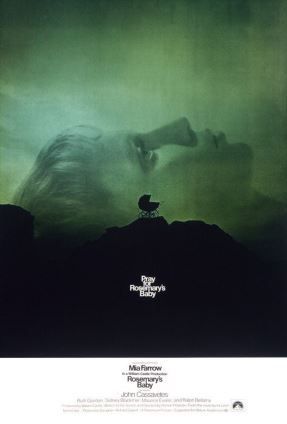 Year Year: 1968 Director: Roman Polanski Writer(s): Roman Polanski Based on: The novel "Rosemary's Baby" by Ira Levin Starring: Mia Farrow, John Cassavetes, Ruth Gordon, Sidney Blackmer, Maurice Evans, Ralph Bellamy, and Angela Dorian Studio: Paramount Country of Origin: USA Language: English Running Time: 136 Minutes Aspect Ratio: 1.85:1 Roesmary’s Baby isn’t exactly a horror movie but it was instrumental in the development of that genre all the same. Before the late 60s horror movies were still primarily defined by the likes of Vincent Price and Boris Karloff and this movie played a big role in both maturing the genre and making it respectable. A psychological thriller at its core, the film brings a frightening situation into a contemporary and urban setting while also bringing a chilling ambiguity to the proceedings. Paranoia is probably the dominant running theme through all of Polanski’s work, and here he explores it to the fullest as Rosemary finds herself torn apart as to whether she’s truly the victim of a satanic conspiracy or simply imagining it because of her own fears of motherhood and her marital problems. The movie does a great job of playing things right down the center up until the last twenty minutes or so when we finally get the chilling reveal and a tantalizingly mysterious ending. The film made Mia Farrow a movie star and also won Ruth Gordon an Oscar, but Polanski was clearly the one who benefited the most from the film’s success. This was the perfect vehicle for the Polish/French director to bring his talents to Hollywood and it set up a long lasting career in English language cinema (even if it was interrupted by some unfortunate actions in his personal life), and for all his future accomplishments I don’t think he ever found a more perfect fusion of his European artistry and his American ambitions.
|
|
Dracula
CS! Gold
 Join Date: Sep 2002
Join Date: Sep 2002
Posts: 26,102 
Likes: 5,731
Location:
Member is Online
|
Post by Dracula on Nov 24, 2015 20:00:59 GMT -5
54. Sunrise: A Song of Two Humans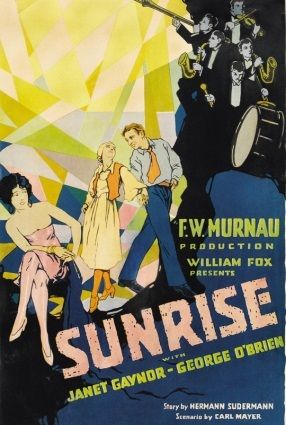 Year Year: 1927 Director: F. W. Murnau Writer(s): Carl Mayer Based on: The short story "The Excursion to Tilsit" by Hermann Sudermann Starring: George O'Brien, Janet Gaynor, and Margaret Livingston Distributor: Fox Film Corporation Country of Origin: USA Language: English Running Time: 95 Minutes Aspect Ratio: 1.33:1 For some reason, the dramatic actors of the silent era have sort of been lost to time. We know all about the major comedic actors of that generation like Chaplin, Keaton, and Lloyd but most dedicated cinemphilles probably can’t even name a dramatic actor from the era with the possible exceptions of Lilian Gish and Rudolph Valentino. That’s a shame because there were some really great performances in these movies and George O'Brien’s work in Sunrise: A Song of Two Humans is among the best. But perhaps I’m burying the lead. This movie is in many ways the final dissertation of the silent era and brings together much of what made it so compelling. The film was made in Hollywood at the very tail end of the silent era but was helmed by the famed German expressionist director F. W. Murnau, who found a way to mix his signature stylistic touches with Hollywood production values. The resulting film doesn’t just feel like one style transplanted so much as a natural evolution on that style. Murnau uses all sorts of really groundbreaking techniques to really get into the characters’ heads and create a sort of parable that’s meant to comment on the wider human condition.
|
|
Dracula
CS! Gold
 Join Date: Sep 2002
Join Date: Sep 2002
Posts: 26,102 
Likes: 5,731
Location:
Member is Online
|
Post by Dracula on Nov 25, 2015 7:37:22 GMT -5
53. The Searchers Year Year: 1956 Director: John Ford Writer(s): Frank S. Nugent Based on: The novel "The Searchers" by Alan Le May Starring: John Wayne, Jeffrey Hunter, Vera Miles, Ward Bond, and Natalie Wood Studio: Warner Brothers Country of Origin: USA Language: English Running Time: 119 Minutes Aspect Ratio: 1.85:1 John Ford is a filmmaker who is generally appreciated more for form than for content these days. His mastery of golden age Hollywood studio filmmaking is consistently admired but his content often lacked ambition. He was a stone cold professional working in a factory-like environment and compromises were inevitable. Every once in a while though he buckled down and made a film that was truly worthy of his talents and no movie did that quite as well as his 1956 masterpiece The Searchers. Though I’m sure many audiences went to the movie expecting just another John Wayne western like many others, what they got was something much grander, much darker, and much more mature than its contemporaries. Though it doesn’t openly criticize its genre the way the “revisionist” westerns would start to do in the next decade, the film does implicitly question some of the values of the genre that made both Wayne and Ford wealthy, specifically the genre’s hostility toward Native Americans. A modern movie would tackle racism by focusing in on the victims of oppression, but here the focus is more on the perpetrators of oppression. It’s a movie about the ways in which hate, and to a lesser extent obsession, twists one's own soul and clouds one’s judgement. The film boldly makes its protagonist a somewhat ambiguous anti-hero, a man who’s understandable desire to save his niece drives him to murderous extremes. It’s a beautifully rendered western any way you cut it, Ford really went above and beyond to make this his masterpiece, but it’s that extra level of ambiguity right up to the film’s iconic final shot that really makes the film stand out from the rest of the pack.
|
|
Doomsday
Administrator  Join Date: Jan 2001
Join Date: Jan 2001
Posts: 23,298 
Likes: 6,764
Location:
Last Online Nov 22, 2024 20:26:39 GMT -5
|
Post by Doomsday on Nov 25, 2015 10:10:45 GMT -5
Too low.
|
|
PG Cooper
CS! Silver
 Join Date: Feb 2009
And those who tasted the bite of his sword named him...The DOOM Slayer
Join Date: Feb 2009
And those who tasted the bite of his sword named him...The DOOM Slayer
Posts: 16,647 
Likes: 4,062
Location:
Last Online Nov 22, 2024 22:27:20 GMT -5
|
Post by PG Cooper on Nov 25, 2015 10:58:04 GMT -5
When it comes to Ford, I probably prefer The Man Who Shot Liberty Valance and probably even The Grapes of Wrath, but The Searchers is right up there.
|
|
Neverending
CS! Platinum
 Join Date: Jul 2003
Join Date: Jul 2003
Posts: 65,773
Likes: 8,648
Location:
Last Online Nov 22, 2024 18:30:10 GMT -5
|
Post by Neverending on Nov 25, 2015 12:10:55 GMT -5
Yeah. Liberty Valance is probably better.
|
|
SnoBorderZero
CS! Silver
 Join Date: Jan 2004
Join Date: Jan 2004
Posts: 17,622 
Likes: 3,182
Location:
Last Online Nov 22, 2024 21:31:20 GMT -5
|
Post by SnoBorderZero on Nov 25, 2015 12:18:27 GMT -5
Nah, The Searchers is his best film.
|
|
Dracula
CS! Gold
 Join Date: Sep 2002
Join Date: Sep 2002
Posts: 26,102 
Likes: 5,731
Location:
Member is Online
|
Post by Dracula on Nov 25, 2015 19:38:48 GMT -5
52. The Three Colors Trilogy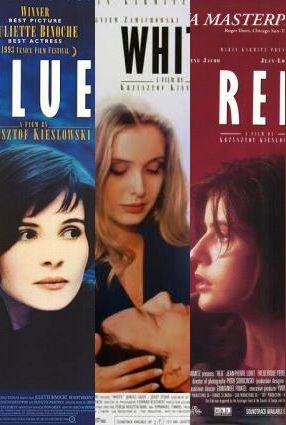
Year: 1993 and 1994 Director: Krzysztof Kieślowski Writer(s): Krzysztof Kieślowski and Krzysztof Piesiewicz Starring: Juliette Binoche, Zbigniew Zamachowski, Julie Delpy, Irène Jacob, and Jean-Louis Trintignant Studio: Canal+ Country of Origin: France Language: French/Polish Running Time: 288 Minutes Aspect Ratio: 1.85:1 “Trilogies” normally refer to sets of sequels designed to milk successes as long as possible, but every once in a while someone embarks to make a trilogy that is themeatic and tonal rather than an attempt to make a single story go on forever. One of the greatest examples of this is Krzysztof Kieślowski’s Three Colors Trilogy, a set of three films that were made one after another and always intended to be viewed together even though they tell three more or less independent stories. The three films are called Blue, White, and Red and each is named in reference to the colors on the French flag and are each meant to be ruminations on what each color represents: Liberty, Equality, and Fraternity. These are however very human stories at their core which deal with far more than just one theme. Blue is a tragedy about a woman finding her own individuality, White is a dark comedy that deals with the differences between Eastern and Western Europe in a post-Cold War world, and Red is a romance of sorts about a friendship between a judge and a part-time model. The three films all feature a striking performances by a different iconic French actresses and all three have beautiful cinematography rooted in their titular colors. Taken as a trilogy the project seems like a wildly ambitious work that makes profound statements about humanity while also being a striking portrait of a Europe at a crossroads.
|
|
PG Cooper
CS! Silver
 Join Date: Feb 2009
And those who tasted the bite of his sword named him...The DOOM Slayer
Join Date: Feb 2009
And those who tasted the bite of his sword named him...The DOOM Slayer
Posts: 16,647 
Likes: 4,062
Location:
Last Online Nov 22, 2024 22:27:20 GMT -5
|
Post by PG Cooper on Nov 25, 2015 21:41:47 GMT -5
Never seen any of em.
|
|
Neverending
CS! Platinum
 Join Date: Jul 2003
Join Date: Jul 2003
Posts: 65,773
Likes: 8,648
Location:
Last Online Nov 22, 2024 18:30:10 GMT -5
|
Post by Neverending on Nov 25, 2015 23:47:16 GMT -5
I like how Dracula is cheating. When you say 100 movies, stick to 100 movies.
|
|
Dracula
CS! Gold
 Join Date: Sep 2002
Join Date: Sep 2002
Posts: 26,102 
Likes: 5,731
Location:
Member is Online
|
Post by Dracula on Nov 26, 2015 1:10:39 GMT -5
I like how Dracula is cheating. When you say 100 movies, stick to 100 movies. I made it known right from the beginning that I'd be treating certain trilogies like this. I'm only doing it when it a trilogy feels like a cohesive work where the three films seem inseparable from the whole. The Lord of the Rings movies were literally shot all at the same time and the three colors trilogy was conceived as a single work that was shot back to back. Admittedly the "before" trilogy is probably a bit more of a stretch but those movies are still pretty intrinsicly linked works. I wasn't about to waste nine slots on the list separating them out just to be a top 100 purist, and trying to rank the individual installments separate from one another would have been madness. For what it's worth I'm only going to be "cheating" on one more slot going forward. |
|
Dracula
CS! Gold
 Join Date: Sep 2002
Join Date: Sep 2002
Posts: 26,102 
Likes: 5,731
Location:
Member is Online
|
Post by Dracula on Nov 26, 2015 8:19:32 GMT -5
51. Do the Right Thing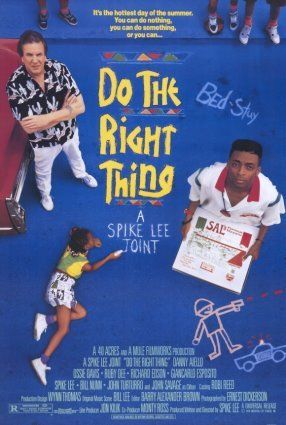 Year Year: 1989 Director: Spike Lee Writer(s): Spike Lee Starring: Spike Lee, Danny Aiello, Giancarlo Esposito, John Turturro, Ossie Davis, Ruby Dee, Richard Edson, Bill Nunn, and John Savage Studio: Universal Country of Origin: USA Language: English Running Time: 120 Minutes Aspect Ratio: 1.85:1 While American film in the late 1960s and 1970s was generally defined by how young and passionate its filmmakers were, the 1980s by contrast seemed oddly middle aged and safe. It was a time of highly establishment filmmaking but the indie film boom was right around the corner and finally seemed to break out in 1989 when Steven Soderbergh’s Sex, Lies, and Videotape faced off against Spike Lee’s Do the Right Thing at the Cannes Film Festival. The former won the Palme but it’s almost certainly the later film that seems like the greater achievement 25 years later. Set over the course of a single day the film shows racial tensions mounting and eventually exploding in a Bed Stuy neighborhood. The film pre-dated the Rodney King beating and the L.A. riots and continues to seem relevant as ever today. But to simply look at it as a movie about racial violence is to miss a lot of great things that are going on in the film. For one, it’s a rather beautiful and colorful work that uses a number of interesting techniques in order to convey the heat of the day and to paint a portrait of what the neighborhood is like. Also, while it gets into some very serious subject matter at times it never feels like a heavy film, hell it’s almost a comedy for large portions of its runtime. Most importantly it was made with a sort of youthful passion by an important voice that was about to take the world by storm. Lee has struggled for most of his career to find this perfect balance again, occasionally he’s gotten close but this remains his biggest home run.
|
|